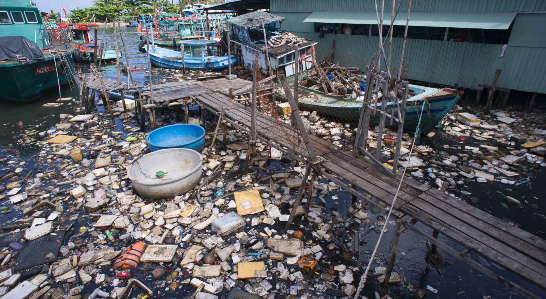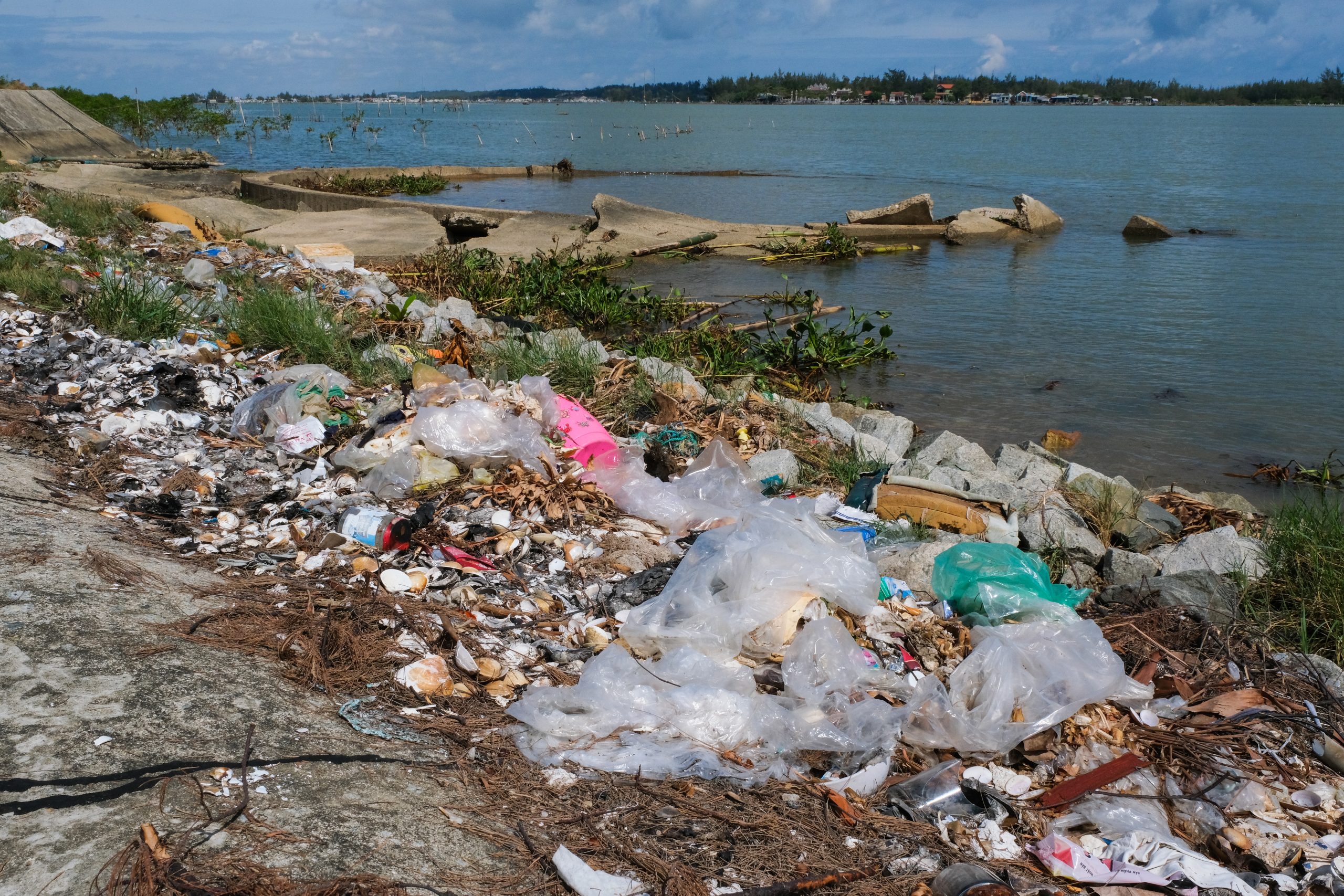DID YOU KNOW: EVERY MINUTE, AN EQUIVALENT OF A 15-TON TRUCK OF PLASTIC WASTE IS DUMPED INTO OUR OCEAN?
150 MILLION TONS OF PLASTIC WASTE IS FLOATING IN OUR OCEAN
8 MILLION TONS OF PLASTIC WASTE END UP IN OUR OCEANS EVERY YEAR
VIET NAM IS THE THIRD HIGHEST PLASTIC CONSUMPTION PER CAPITA IN ASEAN, WITH 41KG each person/YEAR
13% OF THE TOTAL DOMESTIC WASTE IN VIET NAM IS PLASTIC
12-38% PLASTIC WASTE IS NOT COLLECTED AND LEAKED INTO THE ENVIRONMENT
Marine plastic contamination was first reported nearly 50 years ago when less than 50 million tons were produced per year. Only two decades later, plastic pollution rose to an emergency due to commercial production. In 2014, global plastics production surpassed 300 million tons per year1. Plastic waste has been detected on a global scale and in all major ecosystems, in sizes from microns to meters. The ocean currently contains an estimated 150 million tons of plastic, with 8 million tons added every year.


Marine plastic contamination was first reported nearly 50 years ago when less than 50 million tons were produced per year. Only two decades later, plastic pollution rose to an emergency due to commercial production. In 2014, global plastics production surpassed 300 million tons per year1. Plastic waste has been detected on a global scale and in all major ecosystems, in sizes from microns to meters. The ocean currently contains an estimated 150 million tons of plastic, with 8 million tons added every year.
Viet Nam is one of the countries with the largest volume of waste released into the ocean. The World Bank’s study revealed, in 2018 alone, the volume of domestic waste and plastic waste generated in Viet Nam was estimated at over 31 million tons and 5 million tons respectively. Plastic has a share of 64% in packaging materials and looks destined to increase its presence. Only 14% of plastic waste is collected, primarily by the waste collectors, and recycled, by small businesses. The remainder is left at open landfills or dumped directly into the environment. The fact that only 20% of the waste is buried at sanitary landfills makes the matter even worse2. While most of Viet Nam’s landfill sites have overrun their capacity, incinerators have retained simple and outdated technology, failed to control air quality and even faced a high possibility of being damaged by unsorted waste.
10 (ten) cities/districts involved in the project are all located in coastal areas, a region known as a potential source of plastic waste due to its large volume of domestic waste and management difficulties.
Con Dao District, Ba Ria – Vung Tau Province2
Con Dao National Park, an archipelago in the South East Sea, is one of only two Viet Nam’s National Park that has both forest and marine protected areas. Con Dao National Park is rich in seagrass beds (600ha) and corals (1,000ha) and is home to tortoises, green turtles, dolphins and dugongs – one of the most endangered species in Viet Nam and the world. Con Dao also has a treasure trove of turtle nesting sites.
Located in the middle of the ocean, it is inevitable for Con Dao, particularly its mangrove forests and rocky beaches, to be a martyr to plastic pollution. Over the last few years, the rapid increase of tourist arrivals has driven the landfill beyond its capacity. As of now, Con Dao is filled with 70,000 tons of untreated waste. A suggestion made by the District People’s Committee to have trash pressed into packages and shipped to the mainland was put on hold due to its expensive costs. Con Dao National Park collects garbage every year, mostly floating debris trapped in the shores, which ends up with burning treatment.
Cu Lao Cham Marine Protected Area, Quang Nam Province4
A ban on non-biodegradable plastic bags has been carried out for more than 10 (ten) years in Cu Lao Cham Marine Protected Area, under the jurisdiction of Hoi An City, Quang Nam Province. Household waste is sorted, and persistent waste is transported to landfills.
From 2013 to 2019, the volume of domestic solid waste throughout the province rose to 102 tons per day from just 65.7 tons per day. Waste treatment is also limited. In Cam Ha Commune, the composting factory can only receive a small amount of easy-to-decompose waste (16 tons per day), not to mention its damage frequency and its cessation since October 2018
Da Nang city5
Da Nang City is home to developed economies, with the tourism economy being a keystone. By the end of 2019, the volume of domestic solid waste in Da Nang was about 1,100 tons per day. This volume was collected and transported to Khanh Son waste disposal site, Hoa Khanh Nam Ward, Lien Chieu District. Khanh Son site occupies 32.4ha, including a new Khanh Son sanitary landfill, leachate treatment facility, and 13.83-ha canvas-covered domestic garbage dumps. Additionally, a plan has been circulated to upgrade and renovate Khanh Son landfill to a solid waste treatment complex that could contain the potential volume of city waste in the near future.
Regarding management policy, the City People’s Committee announced Decision no. 1577/QĐ-UBND dated April 11, 2019, on the plan to classify domestic solid waste at sources in Da Nang City, and implemented the project “Solid waste management drive waste classification and recycling” in 04 (four) wards of 02 (two) districts including Thach Thang, Thuan Phuoc (Hai Chau) and Thanh Khe Tay, Hoa Khe (Thanh Khe) from 2017-2019.
Dong Hoi City, Quang Binh Province2
A total of 466 tons of plastic waste is produced daily in Quang Binh, a province of 116-km coastline. The waste collection and treatment rate is 77.4%. The province’s landfills total 13, with only 08 (eight) in service.
In addition, 02 (two) waste treatment plants were built in Bo Trach District and Quang Trach District (with a respective capacity of 245 tons and 200 tons per day) along with 01 (one) incinerator in Tien Hoa Commune (with a capacity of 330 kg per day, in operation since 2018).
Regarding management policy, the Provincial People’s Committee called for the Anti-Plastic campaign, in which the management responsibility and practical actions were explored to eliminate single-use plastics and head towards a plastic-free lifestyle. It is also determined that, as of August 2019, the Sunday of the second week of each month will be the “Provincial Clean-Up Day” and the devotion to awareness-raising activities is expected from local authorities to facilitate the reduction of plastics and eco-friendly replacement for single-use plastics.
Ha Tinh City, Ha Tinh Province2
Ha Tinh is a central coastal province adjacent to Quang Binh, distinguished by its 137-km long coastline. The daily volume of domestic solid waste is 650 tons. 90% of waste in urban areas and 70% in rural areas is collected by 211 waste companies in the province. Ha Tinh also has 10 (ten) landfills, 06 (six) incinerators and 02 (two) waste treatment plants. Despite having a designed capacity of 700 tons per day, the actual treated volume in treatment plants is just 220 tons per day.
The first month of the pilot study on waste classification and treatment at sources in 04 (four) central districts ended up with only 28% of the compliance rate. In Ha Tinh, the Women’s Union and related associations advocate Anti-Plastic campaigns in monuments, factories, offices and industrial parks.
Long An Province2
Long An Province, while not bordering on oceans, has long seen the flows of Vam Co Tay River before it reaches the sea. Long An produces an estimated 839 tons of domestic solid waste per day. On average, roughly 560 tons of municipal waste are collected for further treatment and disposal (50% of which is collected in Tan An City and 03 (three) densely populated districts adjacent to Ho Chi Minh City including Ben Luc, Can Giuoc and Duc Hoa).
Tam Sinh Nghia Company, 20km from the city centre, the main waste treatment facility, is currently handling waste collected from Tan An City, Thanh Hoa, Ben Luc, Tan Tru, Tan Thanh, Chau Thanh and a part of Duc Hoa. Waste generated in other districts is either deposited at local landfills or burned in small incinerators. However, nearing their limits, most of these landfill sites could soon be out of service. Besides, part of the waste volume in Duc Hoa, Can Giuoc and Can Duoc District is transported and treated at the disposal complexes in Ho Chi Minh City.
Rach Gia City and Phu Quoc District, Kien Giang Province7, 8
Kien Giang, a coastal province in the southwestern region, is known for having 03 (three) of the best places worth visiting including Rach Gia City, Ha Tien City and Phu Quoc Island. The amount of waste generated daily in urban and rural areas is 450 tons and 400 tons respectively. While the urban collection rate is 402 tons per day, the rural figure is 118 tons per day.
Sorting domestic solid waste at sources has yet to become a popular practice. Out of 02 (two) waste treatment factories, just one called Tam Sinh Nghia Factory, located in My Lam Commune, Hon Dat District is currently in service, handling 180-200 tons of waste per day. Only 30% of the waste collected is recovered for reuse and recycling, including energy recovery and fertiliser production. 12 provincial landfills have long been the source of environmental pollution.
In Rach Gia City, 170 tons of domestic solid waste is generated per day. The collection rate is 84-91%, 72-75% of which is burned, 12-15% is reused as fertilisers and 10-15% is buried.
Phu Quoc is Viet Nam’s important marine protected area. The district authorities revealed a plan to hold “District Clean-Up Day” on the first Saturday of each month since July 2019 and an Action Plan to reduce plastic waste in 2019-2025.
Tuy Hoa City, Phu Yen Province
Tuy Hoa, a small coastal city in Phu Yen Province, produces roughly 130 tons of domestic solid waste per day (510 tons per day at the provincial level). The province collects 390 tons per day, and leaves the rest at residents’ disposal or waiting for collection. 76% of collected waste is buried at the sanitary landfill (Tho Vuc landfill). Given the current economic growth and urbanisation, the amount of waste is likely to overwhelm the landfill. The volume of waste collected has seen an increase of 10-16% per year (Le Hoang Anh et al., 2018). While Song Cau Commune produces 84 tons per day, and other districts total a waste volume of 308 tons per day, Tuy Hoa alone has 132 tons released per day, according to a WWF.
A survey in Tuy Hoa City in 2019, found that plastic waste comprised 18.31% of domestic solid waste, and keeps increasing. Plastic bags, plastic cups and plastic straws are the most observed plastic waste with a share of 60%. The problem is, the majority of plastic waste contains low-quality, nearly-indestructible and nonrecyclable plastics (80%).
Regarding management policy, Phu Yen Provincial People’s Committee issued Plan no. 21/KH-UBND dated January 21, 2019, on the launch of the Anti-Plastic campaign. In addition, Phu Yen officially committed its participation in the Plastic Smart City project – an initiative by WWF – to reduce and eventually cease plastic pollution, with the goal of eliminating 30% of plastic waste leakage by 2025.
Sources:
1: Jambeck et al., “Plastic waste inputs from land into the ocean”, 2015.
2: Ministry of Natural Resources and Environment, 2019.
3: “Collection and Treatment of Domestic Solid Waste in Thua Thien Hue Province 2019” report
4: “Solid Waste Management in Quang Nam Province 2019” report
5: “Current Status of Generation, Collection, Transportation, and Treatment of Domestic Solid Waste in Da Nang City 2019” thematic report
6: Natural Resources and Environmental News, 2019.
7: “Domestic Solid Waste Management in Kien Giang Province 2019” report, Department of Natural Resources and Environment, Kien Giang Province.
8: “Environment Status in Kien Giang Province 2019” report
protect the marine environment
